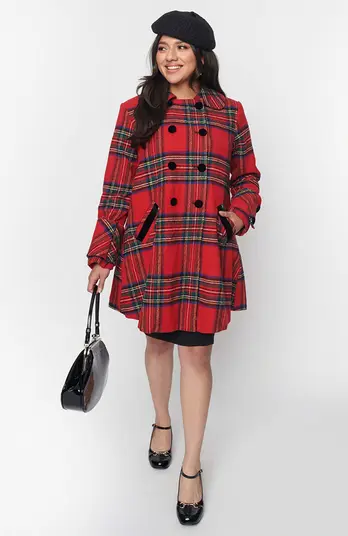AllVintageStyles
Vintage fashion encyclopedia
Peacoat


A 1960s peacoat is a double-breasted wool naval jacket featuring anchor buttons and heavy melton wool construction that transitioned from military utility to civilian fashion, representing classic American maritime heritage and timeless outerwear design.
Quick Facts
- Era: 1960s (military issue and civilian adaptations)
- Origin: United States Navy (military surplus entering civilian fashion)
- Garment Type: Double-breasted wool naval jacket
- Key Identifiers: Anchor buttons, heavy melton wool, double-breasted front, short length
- Typical Resale Price: $80-$300 (authentic vintage pieces)
- Best For: Classic menswear enthusiasts, naval heritage collectors, and timeless outerwear styling
History & Evolution
The peacoat's 1960s era represented the height of military surplus entering mainstream civilian fashion, as post-war prosperity and changing social attitudes made military styling acceptable and desirable for everyday wear. U.S. Navy surplus peacoats from this period featured superior melton wool construction and authentic military specifications designed for harsh maritime conditions.
During the 1960s, the peacoat gained popularity among college students, folk musicians, and style-conscious civilians who appreciated its practical warmth, classic design, and authentic military heritage. The jacket's association with naval tradition and maritime culture appealed to the decade's fascination with Americana and authentic workwear over artificial fashion trends.
The style became a bridge between military function and civilian fashion, worn by everyone from Ivy League students to Greenwich Village artists who valued its unpretentious utility and classic proportions. Quality military contracts ensured superior wool and construction standards that civilian manufacturers often couldn't match. Today, authentic 1960s peacoats are prized for their superior materials and representation of American naval heritage.
Authentication Tips
Authentic 1960s Features:
- Heavy melton wool construction with substantial weight and density
- Anchor-embossed brass or plastic buttons typical of naval issue
- U.S. Navy contract labels with military specifications and dates
- Double-breasted front with wide lapels and short, boxy cut
- Interior pockets and military-grade construction details
Common Reproductions/Modern Pieces:
- Lightweight wool or wool blends lacking authentic melton weight
- Generic buttons without anchor emblems or military markings
- Commercial labels instead of military contract specifications
- Contemporary fitted cuts that alter authentic military proportions
- Poor quality construction lacking military durability standards
Styling & Use Cases
- Best for classic menswear: Pair with wool trousers, button-down shirts, and leather shoes for timeless preppy styling
- Ideal for maritime styling: Style with denim, fisherman sweaters, and boat shoes for authentic nautical aesthetics
- Perfect for utilitarian fashion: Layer over casual wear for practical warmth with authentic military heritage
Modern styling tips:
- Wear over contemporary hoodies or sweaters for updated casual military-inspired looks
- Pair with dark jeans and boots for modern workwear-inspired styling
- Style with vintage band tees and accessories for authentic 1960s counterculture aesthetics
FAQ
Q: How can I tell if a peacoat is authentic 1960s vintage?
A: Look for heavy melton wool construction, anchor-embossed buttons, U.S. Navy contract labels with dates, and authentic military proportions. Genuine pieces show superior wool quality and military-grade construction standards.
Q: What's the typical price range for vintage 1960s peacoats?
A: Authentic vintage peacoats range from $80-$300 depending on condition, military contract authenticity, and size. Military surplus pieces in excellent condition command higher prices among heritage menswear collectors.
Q: How should I care for a vintage 1960s peacoat?
A: Dry clean to preserve the melton wool construction and maintain the coat's military structure. Store hanging with proper shoulder support to prevent distortion of the authentic military silhouette.
Q: What makes 1960s peacoats valuable to collectors?
A: Their authentic U.S. Navy heritage and military specifications, superior melton wool construction compared to civilian alternatives, representation of 1960s military surplus culture, timeless design that remains stylistically relevant, and embodiment of American maritime tradition.
📷: Nordstrom
